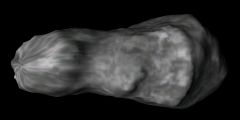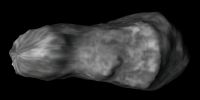4179 Toutatis
| 4179 Toutatis | |||
|---|---|---|---|

| |||
| 4179 Toutatis from MainBeltAsteroids051403.zip in Orbiter 2002P3 | |||
| Designation | |||
| Name | 4179 Toutatis | ||
| Reference body | Sun | ||
| Number of satellites | 0 | ||
| Planetary mean orbits | |||
| Epoch | 2003.441 | ||
| Semimajor axis (a) | 375 618 911 673 m | ||
| Eccentricity (e) | 0.63372709 | ||
| Inclination (i) | 0.4695979278° (0.00819603 radian) | ||
| Longitude of the ascending node (LAN, ☊) | 128.2206691° (2.237872845 radian) | ||
| Longitude of periapsis (ϖ) | 403.0280894° (7.034167138 radian) | ||
| Mean longitude (L) | 638.0077712° (11.13533626 radian) | ||
| Rotational Elements | |||
| Sidereal Rotation Period | 468000 seconds (130 hours) | ||
| Sidereal Rotation Offset | 0 | ||
| Obliquity | 0 radians 0° | ||
| Selected physical parameters | |||
| Mean radius | 1650 m | ||
| Mass | 5×10<su>13 kg | Note | *Elements given are from 951 Gaspra.cfg (MainBeltAsteroids051403) |
951 Gaspra is an asteroid orbiting close to the inner edge of the main asteroid belt. Discovered by Grigory Neujmin on 3 January 1886, it was named after Gaspra, a retreat on Crimea. Gaspra was visited by the Gallileo spacecraft in 1991 as it was enroute to Jupiter. Gaspra is an elongated potato shaped body.
Gaspra in Orbiter
951 Gaspra was first introduced to Orbiter with the release of MainBeltAsteroids051403 in 2003.
Note that the landing surface as given in the config file is spherical, but the visual of these bodies are not, if you land, you will likely be above or below the visual surface.
| Add-on | Source | Version | Author | Type | Release Date | Compatibility | Wiki article |
|---|---|---|---|---|---|---|---|
| Main Belt Asteroids v1.0 | O-F Resources | v1.0 | Unknown OHM Addon Developer | Scenery | 14 May 2003 | ||
Gallery
Closeup of Toutatis imaged by Chang'e 2 during flyby.
| edit The Solar System | |
|---|---|
| Central star |
Sun (Sol) |
| Planets |
Mercury - Venus - Earth - Mars - Jupiter - Saturn - Uranus - Neptune |
| Natural satellites |
Moon - Phobos - Deimos - Io - Europa - Ganymede - Titan - more... |
| Add-ons |
Planets - Dwarf Planets - Small objects - Natural satellites - Alternative star systems |


